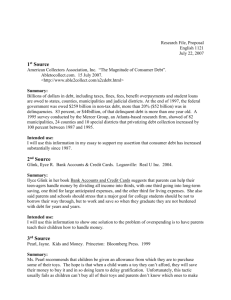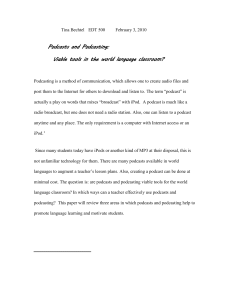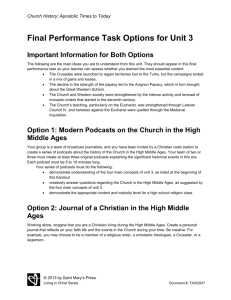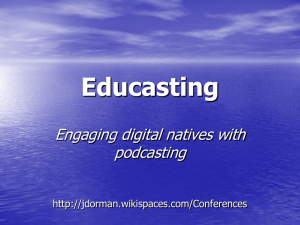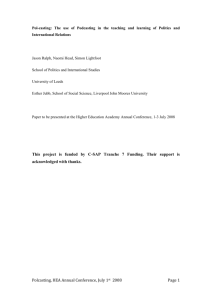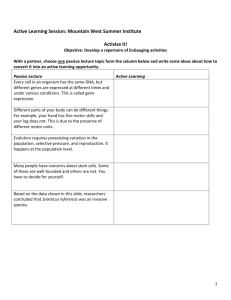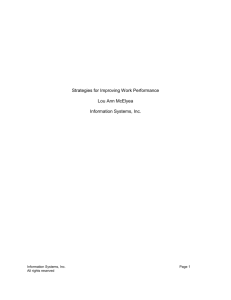RSH9191E Topic Paper
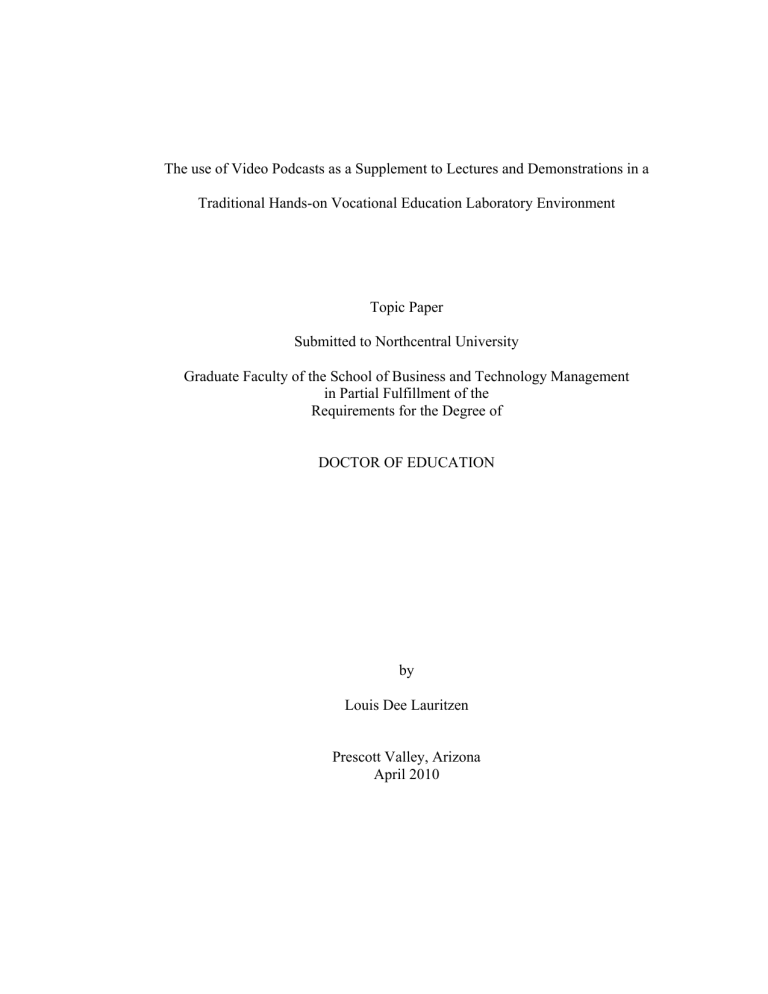
The use of Video Podcasts as a Supplement to Lectures and Demonstrations in a
Traditional Hands-on Vocational Education Laboratory Environment
Topic Paper
Submitted to Northcentral University
Graduate Faculty of the School of Business and Technology Management in Partial Fulfillment of the
Requirements for the Degree of
DOCTOR OF EDUCATION by
Louis Dee Lauritzen
Prescott Valley, Arizona
April 2010
Table of Contents
ii
1
Proposed Topic
Educational technology has made some monumental advances in the past thirty years (Becher-Young, 2009). The advent of personal computers, the internet, cell phones, personal audio and video players, smart whiteboards, media projectors, video games, and the attendant software and applications that accompany these tools of modern living, have all contributed to a whirlwind of educational technology innovations (Moschovitis,
1999; Reiser, 2001a). Educators tend to be on the cutting edge of technology, often driven by their students to implement the latest fad or geek devices (Lucking, 2006). This implementation requires innovation and discipline to not just accept a new technology, but to use it appropriately and to further the cause of education (Reiser, 2001b).
One of the most notable advances in the area of low cost personal technology devices is the iPod or personal audio/video player (Villano, 2008). The use of these personal media players has become nearly pandemic among those under thirty (Harris &
Park, 2008; McGuire, 2007, p. 15). Applying these new devices to education has been the focus of many educators over the past few years. The major applications of this technology, now known as podcasting, has been in what is considered as the traditional academic subjects, slowly moving into the sciences, and now into the career and technical disciplines. Research into the use of these personal audio/video devices in the traditional vocational education subjects of automotive repair and machine shop has been non-existent.
The proposed topic of this research is to investigate the use of podcasts to supplement classroom lecture and demonstrations by providing additional audio/video assets for a student to use in the laboratory environment. This effort will use podcast
2 presentations both as a review of the classroom instruction, and as a tutorial in the setup of a laboratory activity in a traditional machine shop environment or diagnostic and repair procedure in an automotive repair course. This multiple discipline case study will determine if the use of podcasts help students better retain lecture information and perform laboratory tasks with more confidence and accuracy.
Introduction
In 2005 the Oxford University Press declared that Podcast was the word-of-theyear (Oxford University Press, 2005; Skiba, 2006). Although the technology has been around since 2001, the phrase podcast was first coined by journalist Ben Hammersley in
2004 (Copley, 2007). A podcast refers largely to the ability of personal audio players such as Apple’s iPod, to receive downloaded audio and/or video clips on thousands of topics (Educause Learning Initiative, 2005; Skiba). Educators soon jumped onboard and began to investigate how they could use this technology in their curriculum. The obvious application of recording lectures for students to listen to while traveling to and from class was one of the first employed by such secondary institutions as Purdue University,
Drexel University, Allegheny College, University of Chicago, and with Duke University actually distributing iPod devices to students for use in some courses (Copley, Skiba).
The burgeoning wealth of resources and research on the topic of podcasting seems also to have been directed toward specific academic subjects (Allen, 2008; Fratangeli,
2009), or toward specific student or user populations (Chandler, 2009; Checho, 2007;
Janssen, 2009). One population that does not appear to have been considered in the research is that of traditional vocational education, or the time-honored hands-on automotive, wood, metal, machine shop, welding, and building trades courses. While
3 there are a significant number of companies that provide instructional media in these subjects (Insight Media, 2010), the offerings are virtually all directed toward being presented to an entire class, and not distributed to the students in short clips that are reviewable in the laboratory as needed. As these traditional subjects have been around for a long time, there is a great deal of slide show and overhead transparency material that worked well in the 1980’s, but are now out of date. These materials are in great need of being updated and to take advantage of twenty first century technologies. Miller Electric
Manufacturing has recently developed a short series of instructional podcasts that are downloadable from their company website (Miller Electric Mfg. Co, 2009), but this is the exception and not the norm.
Abridged Literature Review
Formal research information on podcasting is relatively small due to its short duration as a research topic (Skiba, 2006). There is, however, a growing volume of data regarding its uses, development, applications, and student learning outcomes (Fratangeli,
2009). While podcasting is a relatively recent phenomenon, the use of electronic media in the classroom or for educational purposes began with the first motion pictures and radio broadcasts as far back as the early 1900’s (Bates as cited in Becher-Young; 2009; Reiser,
2001a). Over the past century the technology and application of these tools have evolved into what we know today as cable or satellite television, video recordings, video games, the internet, and now podcasting (Educause, 2005; Reiser;). As each of these new tools becomes economically feasible to use in the classroom (Deal, 2007; Harris & Park, 2008;
Mikat, Martinez & Jorstad, 2007), educators must discover the proper methods to employ them to their best advantage (Becher-Young; Reiser). While there have been educational
4 videos for decades, these have been for the entire class to view (Insight Media, 2010) and were not “pocket portable” (Rainsbury, 2006). Podcasting consists of using small personal audio/video players to record, download, and/or play information (Becher-
Young; Copley 2007; Deal; Educause; Mikat, Martinez & Jorstad).
Acceptance of new technology often faces resistance from many areas. In Turkey, a developing nation where technology is now becoming available to the general population, a unique opportunity to study how change takes place in an educational environment is presented (Helvaci, 2009). The seemingly gradual changes that have taken place in the United States have taken place in a relatively short period of time and returned some interesting, though not surprising results. Helvaci (2009) found that the major factors in opposing technology advancement were funding issues, teachers themselves resisting the changes, and the lack of or failing infrastructure of communications and physical facilities to accommodate new technologies.
The use of podcasting in the K-12 environment is prevalent (Gatewood, 2008), and teachers at all levels of education are having a great deal of success with student generated podcasts (Dale & Povey, 2009; Harris & Park, 2008; Lee, 2008; Villano,
2008). Current uses of podcasts in the post-secondary classroom are generally centered in the academic subjects such as language arts (Janssen, 2009; Lord, 2008; Schmidt, 2008), the social sciences (Dale & Povey), fine arts (Kerstetter, 2009), business (Hollandsworth,
2007), and hard sciences (Rainsbury & McDonnell, 2006). As more colleges and universities adopt this technology, applications for podcasting have increased to include physical education courses (Mikat, Martinez & Jorstad, 2007), library applications (Lamb
& Johnson, 2007; Rumpler, 2007), economics (Call, Swan & Hofer, 2009), nursing
5
(Billings, 2007), and others. One of the areas that have not seen any significant use of podcasting is that of the traditional hands-on vocational courses such as automotive repair and machine shop.
No matter what the core subject matter is, podcasting has become a particularly significant addition to the distance learning environment in higher education (Becher-
Young, 2009; Copley, 2007; Fratengeli, 2009; Hollandsworth, 2007; Hoskyns-Long,
2009; Hulsman, 2009; Roach, 2006). The very nature of electronic media lends itself to be used as a supplement to online presentations and information distribution. This increased interest in the creation of podcast clips has caused many researchers to include some form of podcast tutorial, distribution help and ideas, or other instructions in their work (Attenweiler, 2008; Call, Hofer & Swan, 2009; Copley; Dale & Povey, 2009; Deal,
2007; Gatewood, 1008; Harris & Park, 2008; Hew, 2009; Kerstetter, 2009; Lucking,
2006; McKee, 2008; Mikat, Martinez & Jorstad, 2007; Villano, 2008).
Allen (2008), Attenweiler (2008), and McGuire (2007) all agree that the instructional design aspect of podcasting is of major concern to educators. But how it is implemented should be well thought out and carefully planned. Allen (2008) found that even though computer hardware in the schools has increased dramatically, the fundamental way teachers use the technology may not have changed much since the days without computers. Attenweiler (2008) was able to create quality podcasts by converting proven PowerPoint presentations into podcasts with very little expense. And McGuire
(2007) found that there are many valid approaches that can be taken, and that well designed delivery can support a variety of learning objectives. In other research the
6 process of analyzing how the podcast supported the educational design was examined
(Allen; Becher-Young, 2009, Hoskyns-Long, 2009).
Learner retention is another major concern to educators who use podcasts in their curriculum (Becher-Young, 2009; Fratangeli, 2009; Janssen, 2009; Schmidt, 2008).
Fratangeli (2009) concluded that there was no significant difference in learner retention when podcasting was implemented and compared to lecture-based courses. These findings were in contrast to Janssen (2009) who noted a twelve to thirteen percent increase in test scores when podcasts were used to supplement a language arts course.
In summary, the literature pertaining to podcasting and its applications is in general agreement that the instructional design and specific application of its use denote the most significant factors to its success or failure. Where some studies have not found any significant improvement in student learning outcomes when podcasts were used, others have found definite gains from the implementation of podcasting in the curriculum. Learner retention and how it is associated with the subject consists of a small, but significant amount of educational research. Podcasting in education began as a tool to supplement in-class lectures and now has evolved into a significant part of distance learning curriculum with application in virtually any discipline. One discipline where podcasting literature was absent was in the area of traditional hands-on vocational courses such as automotive repair and machine shop. Finally, a number of methods and techniques have been described in the available literature instructing educators how to create and distribute podcasts within their curriculum.
The study of podcasting in education is still an open book. Having only been first coined in 2004 (Oxford University Press, 2005), podcasting has become a regular part of
7 distance learning courses and many K-12 and university programs (Hew, 2009). There is still much to overcome in learning how, when, and where to best implement this new technology into the curriculum.
Problem Statement
The use of podcasting in academic subjects has been proven to benefit students by allowing them to review lecture material and investigate additional topics related to what was presented in the textbook or classroom lecture (Allen, 2008; Chandler, 2009;
Checho, 2007; Fratangeli, 2009;Jansen, 2009). In the traditional hands-on vocational education curriculum of automotive repair and machine shop, the use of podcasting has not been widely used, accepted, or researched. This study will discover if the use of podcasts help students better achieve educational learning outcomes in these vocational education disciplines. This objective will be accomplished by providing students with podcasts to supplement instructor-led presentations. Podcasts will contain information such as visual demonstrations of laboratory exercise setup instructions, machine tool and equipment operation, and problem diagnostic procedures. Students will be able to refer to these podcasts during the laboratory exercise.
Purpose Statement
The purpose of this case study will be to discover the effect of using podcasting in traditional vocational education courses for machine shop and automotive repair students at a rural community college. Students range in age from fifteen year old high school sophomores to retired individuals in their sixties. The average class size is between ten to twenty individuals with an average of between five to twenty percent women. The traditional vocational education student is one that feels very adept with using their hands
8 and mind in the development, construction, and/or repair of physical objects. This study will compare the ability of students to learn and retain information presented to them through traditional instructor-led lectures and demonstrations, with the additional assistance of a podcast for reference and reinforcement when working on laboratory assignments.
The research design will consist of selecting vocational classes from each of the machine shop and automotive repair programs at the college level. Each class will be separated into two random groups. In each discipline, both control and test groups will be given the same traditional lecture and instructional material. The test groups will also be given a video podcast of the instructional material and demonstration of the lab activity pre-loaded on the podcast device. The control groups will not be allowed to use or view these extra materials but will need to rely on the notes they took during the instructor-led lecture and demonstration.
On subsequent assignments the groups will be switched so the first group that was able to use the podcast will not be able to do so in the next assignment, etc. After four assignments each group will have been able to use the extra podcast media resources in two out of the four activities. They will be assessed on skill and knowledge retention levels for each assignment. Assessment will consist of traditional techniques appropriate for each laboratory activity. Comparative data will be collected with respect to which discipline and group each individual was part of. The resulting data will be used to evaluate if the use of podcast information helped to improve the student performance outcomes for each activity tested.
9
At the conclusion of the study, students will be given a short survey to determine their usage of the available podcasts, or lack thereof. Students will be asked their opinions as to whether they felt the use of the podcast media was of value to them in their learning situation. This survey will then be compared to the assessment results to evaluate the actual value of podcasting in this situation.
Research Questions
1.
Do students better understand and retain instructional information when podcasts are used in the curriculum? This question is fundamental and the assumption that students can benefit from using podcast technology to assist them in understanding and retaining instructional information is essential to this study.
2.
This question can largely be answered through a review of literature with the added results from the case study research approach identified in this study. It is anticipated that the method that podcasts are used will vary depending on the intent of the podcast, learning outcomes, and the educational discipline where it being used. An additional look into the learning styles of students participating in the study. A traditional vocational student may tend to be more visual and handson than a math major and the use of podcasting may be well suited for student who is learns best with direct tactile interaction with their work.
How are podcasts currently being used in education curricula? This question will be answered through a review of literature. It is anticipated that the use of podcasting is generally confined to recording course lectures and being made available for students to download for review. Students then use the podcasts in conjunction with their in-class notes for studying and preparing for exams. This
3.
4.
10 question is essential to understand in order to proceed with development of this study.
How can podcasts be used to assist students complete laboratory projects in traditional vocational education automotive repair and machine shop courses?
This question will be answered through a systematic case study approach.
Students will be provided with podcast information to assist them in their lab work and supplement instructor-led lecture and demonstrations. It is anticipated that students will find the podcast media helpful in laboratory exercise setup instructions, machine tool and equipment operation, and problem diagnostic procedures.
How do students benefit from the use of podcasts in a traditional vocational education course laboratory (working shop) environment? At the conclusion of the study, students will be surveyed to determine their use of podcasts during the study, and if they felt they received any benefit from the use of podcasts in the curriculum. In conjunction with the student survey, test scores and laboratory assignment grades will be assessed and compiled to help determine if the use of podcasts actually affected the educational learning outcomes. Two traditional vocational education disciplines, automotive repair and machine shop, will be explored concurrently and used in this study. These disciplines are both similar in their hands-on nature, but would likely have different students participating in the courses. The inclusion of multiple disciplines allows for a more diversified use of podcasts in the study. Multiple disciplines also results a larger population of
11 students available to participate in the study, due to the small rural community college environment where the study is being preformed.
Summary
Podcasting is the use of personal media players to present entertainment, commercial, or educational information (Educause, 2005). Many schools from K-12 through the university level have adapted this recent technology to the classroom (Harris,
2008; Hew, 2009). Originally used as a way to record and playback in-class lectures, it has now become a staple in distance learning courses, and is widely used in most academic disciplines (Copley, 2007).
User or student developed podcasts are popular in many areas of instruction as a means of immersing students in a topic or subject (Dale & Povey, 2009; Lee, 2008). The production of such a podcast requires participants to research, study, plan, and otherwise get personally involved with the subject in order to complete an assignment. There are still many issues that arise in the development and implementation of podcasts. The lack of experience by the developer in using recording and editing equipment, or a weak or non-existent instructional design can cause frustration, failure, and poor results from the final product (Becher-Young, 2009; Helvaci, 2009).
Each application of podcasting is unique and specific to the discipline or topic being presented. As a result, any global generalizations on the use of podcasts are inappropriate. What works for one instructor and group of students may not be effective in another environment (Salmon & Gdirisingha, 2008).
The use of podcasts in a traditional automotive repair and machine shop curriculum has essentially been non-existent. This study will investigate the application
12 of podcast technology within these disciplines and how it can be used as a supplement to lectures and demonstrations when students work on their laboratory activities.
References
Allen, G. (2008). Practicing teachers and web 2.0 technologies: Possibilities for transformative learning. (Ed.D., Teachers College, Columbia University). , 478.
Retrieved from http://proquest.umi.com.proxy1.ncu.edu/pqdweb?did=1601499661&Fmt=7&clien tId=52110&RQT=309&VName=PQD. (3327101)
Attenweiler, W. J., Bryant, G. A., Lively, M., & Greene, A. (2008). Podcasting from
PowerPoint made easy for faculty.
Kentucky Journal of Excellence in College
Teaching & Learning, 6 , 11-18. Retrieved from http://search.ebscohost.com/login.aspx?direct=true&db=ehh&AN=38708785&sit e=ehost-live
Becher-Young, L. (2009). Learn on the run: A study of instructional design practices in podcasting. (Ph.D., Capella University). , 157. Retrieved from http://proquest.umi.com.proxy1.ncu.edu/pqdweb?did=1907324911&Fmt=7&clien tId=52110&RQT=309&VName=PQD. (3378825)
Call, C., Hofer, M., & Swan, K. O. (2009). Hot off the presses: Podcasting for the economics classroom.
Social Studies Research & Practice, 4 (2), 145-151.
Retrieved from http://search.ebscohost.com/login.aspx?direct=true&db=ehh&AN=43938668&sit e=ehost-live
Chandler, N. (2008). Assessing podcasting as a learning methodology for digital natives and digital immigrants in the corporate learning environment. (Ph.D., Indiana
State University). , 90. Retrieved from http://proquest.umi.com.proxy1.ncu.edu/pqdweb?did=1798967481&Fmt=7&clien tId=52110&RQT=309&VName=PQD. (3358473)
Checho, C. (2007). The effects of podcasting on learning and motivation: A mixed method study of at-risk high school students. (Ph.D., University of Nevada,
Reno). , 245. Retrieved from http://proquest.umi.com.proxy1.ncu.edu/pqdweb?did=1453185481&Fmt=7&clien tId=52110&RQT=309&VName=PQD. (3289459)
Copley, J. (2007). Audio and video podcasts of lectures for campus-based students:
Production and evaluation of student use.
Innovations in Education and Teaching
International, 44 (4), 387. Retrieved from
13 http://proquest.umi.com.proxy1.ncu.edu/pqdweb?did=1379908171&Fmt=7&clien tId=52110&RQT=309&VName=PQD
Dale, C., & Povey, G. (2009). An evaluation of learner-generated content and podcasting.
Journal of Hospitality, Leisure, Sports and Tourism Education, 8 (1), 117.
Retrieved from http://proquest.umi.com.proxy1.ncu.edu/pqdweb?did=1737417131&Fmt=7&clien tId=52110&RQT=309&VName=PQD
Deal, A. (2007). A teching with technology white paper: Podcasting.
Retrieved
4/10/2010, 2010, from http://www.cmu.edu/teaching/resources/PublicationsArchives/StudiesWhitepaper s/Podcasting_Jun07.pdf
EDUCAUSE Learning Initiative. (2005). 7 things you should know about podcasting
(ID: ELI7003) | EDUCAUSE Retrieved 2/22/2010, 2010, from http://www.educause.edu/ELI/7ThingsYouShouldKnowAboutPodca/156806
Fratangeli, J. (2009). The impact of podcasting on learner knowledge retention. (Ph.D.,
Capella University). , 161. Retrieved from http://proquest.umi.com.proxy1.ncu.edu/pqdweb?did=1907294121&Fmt=7&clien tId=52110&RQT=309&VName=PQD. (3378813)
Harris, H., & Park, S. (2008). Educational usages of podcasting.
British Journal of
Educational Technology, 39 (3), 548551. doi:10.1111/j.1467-8535.2007.00788.x
Helvaci, M. (2009). An evaluation of changes in the curriculum in elementary school level in turkey.
Education, 130 (2), 308. Retrieved from http://proquest.umi.com.proxy1.ncu.edu/pqdweb?did=1937522531&Fmt=7&clien tId=52110&RQT=309&VName=PQD
Hew, K. F. (2009). Use of audio podcast in K-12 and higher education: A review of research topics and methodologies.
Educational Technology Research and
Development, 57 (3), 333-357.
Hollandsworth, R. J. (2007). Managing the podcast lecture: A hybrid approach for online lectures in the business classroom.
TechTrends, 51 (4), 39. Retrieved from http://proquest.umi.com.proxy1.ncu.edu/pqdweb?did=1316751301&Fmt=7&clien tId=52110&RQT=309&VName=PQD
Hoskyns-Long, G. (2009). Trends in mobile learning: A study of the adoption of podcasting as a learning tool at a community college. (Ph.D., Capella University).
, 136. Retrieved from http://proquest.umi.com.proxy1.ncu.edu/pqdweb?did=1797600471&Fmt=7&clien tId=52110&RQT=309&VName=PQD
14
Hulsmann, T. (2009). In Salmon G., Edirisingha P. (Eds.), Podcasting for learning in universities. Maidenhead, England ; Open University Press, 2008. Retrieved from http://proquest.umi.com.proxy1.ncu.edu/pqdweb?did=1941104791&sid=1&Fmt=
3&clientId=52110&RQT=309&VName=PQD
Insight Media. (2010). Insight media - educational and training videos for classrooms.
Retrieved 2/10/2010, 2010, from http://insight-media.com/IMGroupDispl.asp
Janssen, B. (2009). Using podcasts to teach the difference between 'ser' and 'estar' in a first semester Spanish course. (M.A., Southern Illinois University at Carbondale).
, 90. Retrieved from http://proquest.umi.com.proxy1.ncu.edu/pqdweb?did=1791982351&Fmt=7&clien tId=52110&RQT=309&VName=PQD. (1465026).
Kerstetter, K. (2009). Educational applications of podcasting in the music classroom.
Music Educators Journal, 95 (4), 23. Retrieved from http://proquest.umi.com.proxy1.ncu.edu/pqdweb?did=1740351491&Fmt=7&clien tId=52110&RQT=309&VName=PQD
Lamb, A., & Johnson, L. (2007). Podcasting in the school library, part 1: Integrating podcasts and vodcasts into teaching and learning.
Teacher Librarian, 34 (3), 54.
Retrieved from http://proquest.umi.com.proxy1.ncu.edu/pqdweb?did=1204860731&Fmt=7&clien tId=52110&RQT=309&VName=PQD
Lee, M. J. W., McLoughlin, C., & Chan, A. (2008). Talk the talk: Learner-generated podcasts as catalysts for knowledge creation British Journal of Educational
Technology, 39 (3), 501- 521. doi:10.1111/j.1467-8535.2007.00746.x
Lord, G. (2008). Podcasting communities and second language pronunciation.
Foreign
Language Annals, 41 (2), 364. Retrieved from http://proquest.umi.com.proxy1.ncu.edu/pqdweb?did=1514361041&Fmt=7&clien tId=52110&RQT=309&VName=PQD
Lucking, R. A., & Christmann, E. P. (2006). Can you podcast?
Science Scope, 30 (1), 16-
16. Retrieved from http://search.ebscohost.com/login.aspx?direct=true&db=ehh&AN=23911437&sit e=ehost-live
McGuire, M. (2007). Exploring the factors that determine web-based medium effectiveness: A case study. (D.Sc., Robert Morris University). , 91. Retrieved from http://proquest.umi.com.proxy1.ncu.edu/pqdweb?did=1417816251&Fmt=7&clien tId=52110&RQT=309&VName=PQD. (3287686)
McKee, W. A., Harrison, D. K., & Allan, M. (2008). Evaluation of methods of volumeproduction of vodcasts of presentations.
International Journal of Emerging
15
Technologies in Learning, 3 (4), 85-89. Retrieved from http://search.ebscohost.com/login.aspx?direct=true&db=ehh&AN=35446320&sit e=ehost-live
Mikat, R. P., Martinez, R. D., & Jorstad, J. A. (2007). Podcasting for your class.
Journal of Physical Education, Recreation & Dance, 78 (5), 14. Retrieved from http://proquest.umi.com.proxy1.ncu.edu/pqdweb?did=1326854601&Fmt=7&clien tId=52110&RQT=309&VName=PQD
Miller Electric Mfg. Co. (2009). DIY newsletter.
Retrieved 2/17/2010, 2010, from http://millerelectric.cmail1.com/T/ViewEmail/y/115B772042506FD8/077E98446
9ED0DCF9A8E73400EDACAB4
Moschovitis, C. J. P., Poole, H., Schuyler, T., & Senft, T., M. (1999). History of the internet: A chronology, 1843 to present . Santa Barbara, California, United States:
ABC Clio Ltd.
Oxford University Press. (2005). "Podcast" is the word of the year.
Retrieved 2/22/2010,
2010, from http://www.oup.com/us/brochure/NOAD_podcast/?view=usa
Rainsbury, J. W., & McDonnell, S. M. (2006). Podcasts: An educational revolution in the making?
Retrieved from http://www.ncbi.nlm.nih.gov/entrez/query.fcgi?db=pmc&cmd=Retrieve&dopt=A bstractPlus&query_hl=&itool=pubmed_docsum&list_uids=1557886;
Reiser, R. A. (2001a). A history of instructional design and technology: Part I: A history of instructional media.
Educational Technology Research and Development
[H.W.Wilson - EDUC], 49 (1), 53. Retrieved from http://proquest.umi.com.proxy1.ncu.edu/pqdweb?did=71395499&Fmt=7&clientI d=52110&RQT=309&VName=PQD
Reiser, R. A. (2001b). A history of instructional design and technology: Part II: A history of instructional design.
Educational Technology Research and Development
[H.W.Wilson - EDUC], 49 (2), 57. Retrieved from http://proquest.umi.com.proxy1.ncu.edu/pqdweb?did=74678645&Fmt=7&clientI d=52110&RQT=309&VName=PQD
Roach, R. (2006). HBCU first in North Carolina system to join iTunes U program.
Diverse Issues in Higher Education, 23 (9), 26. Retrieved from http://proquest.umi.com.proxy1.ncu.edu/pqdweb?did=1071055601&Fmt=7&clien tId=52110&RQT=309&VName=PQD
Rumpler, A. (2007). Podcasting in library research: A discussion of three projects developed using new audio technologies.
International Association of School
Librarianship.Selected Papers from the ...Annual Conference, , 1. Retrieved from http://proquest.umi.com.proxy1.ncu.edu/pqdweb?did=1563504601&Fmt=7&clien tId=52110&RQT=309&VName=PQD
16
Salmon, G. & Edirisingha, P. (Eds). (2008). Podcasting for learning in universities .
Maidenhead, England ; Open University Press. ISBN 9-780335-234295
Schmidt, J. (2008). Podcasting as a learning tool: German language and ure every day.
Die Unterrichtspraxis, 41 (2), 186. Retrieved from http://proquest.umi.com.proxy1.ncu.edu/pqdweb?did=1645365391&Fmt=7&clien tId=52110&RQT=309&VName=PQD
Skiba, D. J. (2006). The 2005 word of the year: Podcast.
Nursing Education Perspectives,
27 (1), 54. Retrieved from
Villano, M. (2008). Building a better podcast.
T.H.E.Journal, 35 (1), 31-33,.
